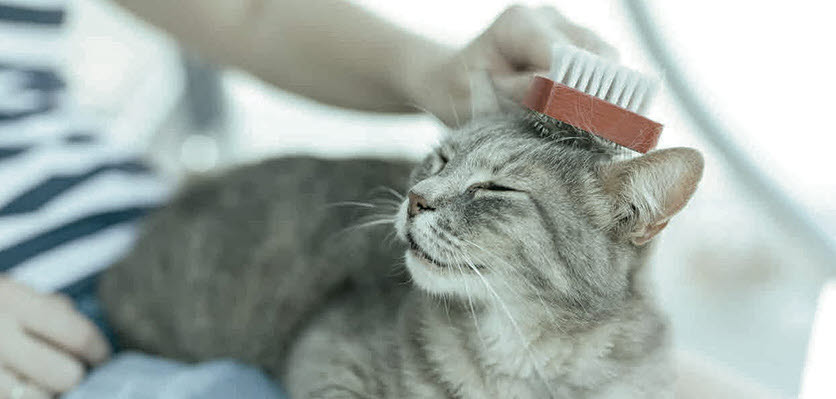Does my cat need a bath?

Coat care
Unless a cat is unwell, they will generally perform thorough daily self-grooming, involving licking their face, body, paws and bottom area. For most short-haired cats, this keeps them neat and tidy. However, all cats will benefit from being groomed by their owner regularly to remove loose hairs.
This not only reduces fur shedding onto your clothes and around your house but can also help decrease hairball ingestion by your cat. Grooming your cat is also a great time to check them for any skin lumps or other lesions that would benefit from a veterinary examination.
For most short-haired cats, a simple rubber brush or ‘slicker’ brush twice weekly to remove any loose hairs is sufficient. Long-haired cats generally require daily combing and brushing to prevent the formation of tangles and remove loose hairs.
A combination of pet combs, slicker brushes, and ‘de-shedding’ tools can be used. Be sure to pay extra attention to the areas behind your cat’s ears, under their belly, and at the back of their legs, as these are areas where tangles frequently occur.
Some cats benefit from careful clipping of the coat, using pet-safe clipper blades. You can purchase these to use on your pet at home, or have a groomer or veterinary nurse perform the clip for you. Pets that may require partial or total clipping include:
- Elderly or unwell pets who are unable to keep up with their own grooming requirements
- Cats who get faecal material stuck in the fur around their bottom
- Any pet with matting of fur close to the skin. The use of scissors to remove the matted hair should be avoided, as it is very easy to accidentally cut your pet’s skin
- Long-haired cats in warm climates
- Long-haired cats in tick-endemic areas (where clipping will help you check them for ticks more easily), or areas with high levels of seasonal grass seeds that can tangle in your pet’s fur
Anxious cats, or cats that have matted fur, will often require sedation or a general anaesthesia by a veterinarian to ensure that the coat can be safely clipped.
Bathing
In most cases, your cat will not routinely require bathing. However, from time to time, a bath may be required if your cat’s fur has been soiled with a substance that they’ll have difficulty grooming out (e.g. diarrhoea) or something that is unsafe for them to lick (e.g. paint or tar). In these cases, it’s best to contact your local veterinarian for advice on the best way to clean your cat.
Sometimes a bath at home with pet-safe shampoo will be sufficient, provided your cat will cooperate! Anxious cats or very soiled cats may require sedation by the veterinarian in order for the cat to be safely bathed.
Hairless breeds such as the Sphynx are the exception to the rule, as their naked skin exudes oils which attract dirt and dust. These cats generally require either bathing once a week in a gentle or veterinary medicated shampoo, or twice-weekly wiping down with suitable pet wipes including gently cleaning in and around any skin folds.
Regular grooming will not only keep your cat healthy and comfortable but will help to strengthen your bond with them.
